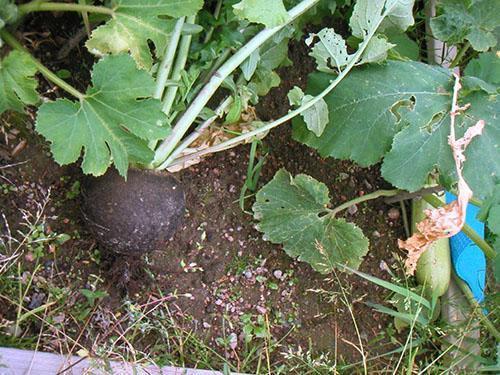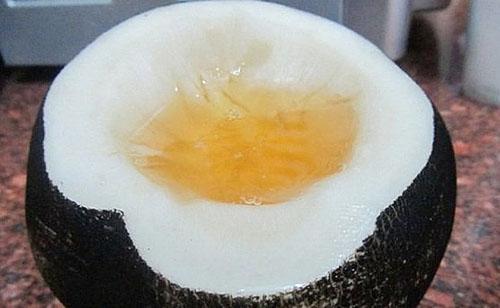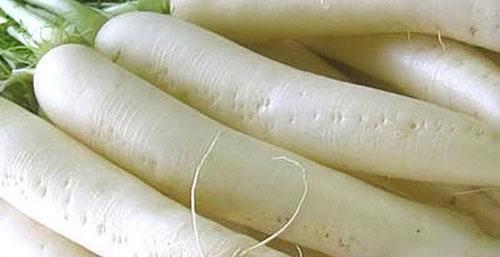When to remove radish from the garden in the country
 For a gardener and gardener, it is important not only to grow an ecologically clean crop, but also to collect it in time, properly store it in order to please their loved ones with fragrant fresh fruits in winter. Today we will look at when to collect radish from the garden and how to properly store the crop in winter.
For a gardener and gardener, it is important not only to grow an ecologically clean crop, but also to collect it in time, properly store it in order to please their loved ones with fragrant fresh fruits in winter. Today we will look at when to collect radish from the garden and how to properly store the crop in winter.
Proper storage of the radish will ensure the safety of all minerals and vitamins that a person needs.
Nutritional and medicinal value of radish

- sodium - 17 mg;
- potassium - 260-1200 mg;
- magnesium - 28 mg;
- iron - 1.5 mg;
- phosphorus - 26 mg;
- iodine - 8 mg.
All radishes are rich in essential substances. Different types of radish contain from 9 to 50 mg of oils per 100 grams of dry matter. The radish also contains bactericidal and phytoncidal substances.
The composition of vitamins in the radish:
- carotene - 0.023 mg;
- B1 - 0.033 mg;
- B2 - 0.03 mg;
- PP - 0.25 mg;
- B5 - 0.18 mg;
- B6 - 0.06 mg;
- C - 30-70 mg.
Since ancient times, radish has been used in medicine as a digestive stimulant, as an expectorant. And doctors still recommend radish with honey for a cold cough.
Diversity of species composition of radish
 There were times when the gardeners of our country grew only one type of radish - winter black. But times are changing, and now more and more often in the gardens there are various previously considered exotic, including sweet radishes. For example, daikon is a sweet Chinese radish. Our daikon radish is a cousin or even a second cousin. The taste is more like not a radish, but like radish.
There were times when the gardeners of our country grew only one type of radish - winter black. But times are changing, and now more and more often in the gardens there are various previously considered exotic, including sweet radishes. For example, daikon is a sweet Chinese radish. Our daikon radish is a cousin or even a second cousin. The taste is more like not a radish, but like radish.
 Margelan radish, or lobo, tastes a cross between daikon and European bitter radish. Usually root vegetables are white or green, round or elongated. The "Red Heart" variety is interesting in that under the light green peel there is a watermelon-colored red core.
Margelan radish, or lobo, tastes a cross between daikon and European bitter radish. Usually root vegetables are white or green, round or elongated. The "Red Heart" variety is interesting in that under the light green peel there is a watermelon-colored red core.
 Green radish has a more pleasant delicate taste in comparison with black radish. This native of Uzbekistan is slightly less rich in vitamins, but also has healing properties.
Green radish has a more pleasant delicate taste in comparison with black radish. This native of Uzbekistan is slightly less rich in vitamins, but also has healing properties.
When to remove radish from the garden
 To preserve the nutritional and medicinal properties of the radish, you need to clearly understand when to remove the radish from the garden. There are varieties of the so-called summer radish, which are sown in early spring in greenhouses or film shelters for summer consumption. Summer radish begins to be selectively harvested in early June when the root crop reaches a diameter of three to four centimeters. The final decision on when to harvest summer radish is made in late June - early July, depending on the marketability of root crops. Store such a radish in the refrigerator for no more than a month.
To preserve the nutritional and medicinal properties of the radish, you need to clearly understand when to remove the radish from the garden. There are varieties of the so-called summer radish, which are sown in early spring in greenhouses or film shelters for summer consumption. Summer radish begins to be selectively harvested in early June when the root crop reaches a diameter of three to four centimeters. The final decision on when to harvest summer radish is made in late June - early July, depending on the marketability of root crops. Store such a radish in the refrigerator for no more than a month.
 Things are completely different with radish intended for winter storage. In order for the root crops to gain a maximum of useful substances and to be well stored all winter, the radish is harvested as late as possible. Single frosts do not greatly harm root crops, but the radish must be removed for the winter before the onset of stable frosts. In central Russia and in the Urals, you can harvest radish starting from Pokrov (October 14).
Things are completely different with radish intended for winter storage. In order for the root crops to gain a maximum of useful substances and to be well stored all winter, the radish is harvested as late as possible. Single frosts do not greatly harm root crops, but the radish must be removed for the winter before the onset of stable frosts. In central Russia and in the Urals, you can harvest radish starting from Pokrov (October 14).
When harvesting, the radish is sorted, rejecting overgrown, small and ugly roots. Vegetables are thoroughly cleaned of soil residues and the tops are cut off.It is better to leave the tails, which will enable the root crop to remain fresh and juicy for longer.
Storing radish in winter
 After cleaning and cutting, the roots are laid out in one or two rows to dry. This is especially true if the weather was wet before cleaning. After a few days, the radish is examined, sorted out and put into final storage. You can store the radish in different ways, but the temperature and humidity conditions must be observed. The air temperature should range from zero to three degrees Celsius, with a relative humidity of 85-90 percent.
After cleaning and cutting, the roots are laid out in one or two rows to dry. This is especially true if the weather was wet before cleaning. After a few days, the radish is examined, sorted out and put into final storage. You can store the radish in different ways, but the temperature and humidity conditions must be observed. The air temperature should range from zero to three degrees Celsius, with a relative humidity of 85-90 percent.
Radish can be stored in basements and cellars along with potatoes, carrots and other vegetables, filling up to a meter high. Also, the roots are stacked in stacked wooden boxes. Root crops are very well preserved in slightly damp river sand, so they almost do not lose their elasticity and marketability.
With a large amount of radish, it can be stored in earthen piles. How to store black radish in piles is very simple, like potatoes, or better - with it. We spread the root crops at the bottom of the dug trench, sprinkle it with a layer of soil of 15 centimeters, then lay the straw. We finally fill the burt with a layer of earth with a mound for precipitation drainage.
You can also lower boxes of radish into the trench, fill them with sand or earth, then lay a layer of dry straw to preserve heat and close the trench with improvised materials. In such a mini-cellar, you can arrange a ventilation hood using a piece of metal or plastic pipe.
After the radish is brought from the cellar, it is stored in the vegetable compartment in the refrigerator. The gardener will undoubtedly be rewarded for proper timely cleaning and reliable storage with simple or exquisite vitamin radish salads that fill the house with summer aromas during cold winters.